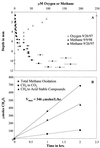Molecular characterization of methanotrophic isolates from freshwater lake sediment
- PMID: 11097900
- PMCID: PMC92454
- DOI: 10.1128/AEM.66.12.5259-5266.2000
Molecular characterization of methanotrophic isolates from freshwater lake sediment
Abstract
Profiles of dissolved O(2) and methane with increasing depth were generated for Lake Washington sediment, which suggested the zone of methane oxidation is limited to the top 0.8 cm of the sediment. Methane oxidation potentials were measured for 0.5-cm layers down to 1.5 cm and found to be relatively constant at 270 to 350 micromol/liter of sediment/h. Approximately 65% of the methane was oxidized to cell material or metabolites, a signature suggestive of type I methanotrophs. Eleven methanotroph strains were isolated from the lake sediment and analyzed. Five of these strains classed as type I, while six were classed as type II strains by 16S rRNA gene sequence analysis. Southern hybridization analysis with oligonucleotide probes detected, on average, one to two copies of pmoA and one to three copies of 16S rRNA genes. Only one restriction length polymorphism pattern was shown for pmoA genes in each isolate, and in cases where, sequencing was done, the pmoA copies were found to be almost identical. PCR primers were developed for mmoX which amplified 1.2-kb regions from all six strains that tested positive for cytoplasmic soluble methane mono-oxygenase (sMMO) activity. Phylogenetic analysis of the translated PCR products with published mmoX sequences showed that MmoX falls into two distinct clusters, one containing the orthologs from type I strains and another containing the orthologs from type II strains. The presence of sMMO-containing Methylomonas strains in a pristine freshwater lake environment suggests that these methanotrophs are more widespread than has been previously thought.
Figures





References
-
- Anthony C. The biochemistry of methylotrophs. London, England: Academic Press, Inc.; 1982.
-
- Bender M, Martin W, Hess J, Sayles F, Ball L, Lambert C. A whole-core squeezer for interfacial pore-water sampling. Limnol Oceanogr. 1987;32:1214–1225.
-
- Cicerone R J, Oremland R S. Biogeochemical aspects of atmospheric methane. Global Biogeochem Cycles. 1988;1:61–86.
Publication types
MeSH terms
Substances
Associated data
- Actions
- Actions
- Actions
- Actions
- Actions
- Actions
- Actions
- Actions
- Actions
- Actions
LinkOut - more resources
Full Text Sources
Other Literature Sources
Molecular Biology Databases

